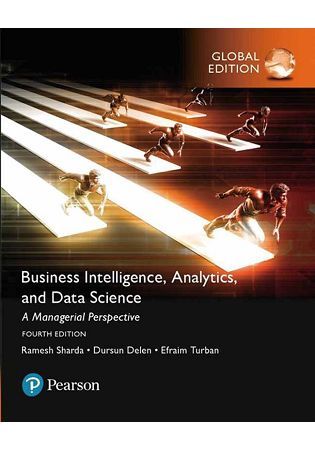For courses on Business Intelligence or Decision Support Systems.
A managerial approach to understanding business intelligence systems.
To help future managers use and understand analytics, Business Intelligence provides students with a solid foundation of BI that is reinforced with hands-on practice.
本書特色
For courses on Business Intelligence or Decision Support Systems.
A managerial approach to understanding business intelligence systems.
To help future managers use and understand analytics, Business Intelligence provides students with a solid foundation of BI that is reinforced with hands-on practice.
See the decision-making aspects: Managerial Approach. This text takes a managerial approach to Business Intelligence (BI), emphasizing the applications and implementations behind the concepts. This approach allows students to understand how BI works in a way that will help them adopt these technologies in future managerial roles.
Put the concepts into action: Access to the Teradata Network. Teradata University Network (TUN) is a free learning portal sponsored by Teradata, a division of NCR, whose objective is to help faculty learn, teach, communicate, and collaborate with others in the field of BI. Teradata also supports a student portal (teradatastudentnetwork.com) that contains a variety of learning resources such as cases, Web seminars, tutorials, exercises, links to sources, and more. Business Intelligence is interconnected with TUN via various hands-on assignments provided in all chapters and is accessible to students through the portal.
Understand the context: Real-world Orientation. Extensive, vivid examples from large corporations, small businesses, and government and not-for-profit agencies make the difficult concepts more accessible and relevant. International examples of global competition, partnerships, and trade are also provided throughout. These real-world case studies show students the capabilities of BI, its cost and justification, and the innovative ways real corporations are using BI in their operations.
Opening Vignette: Real world case that presents a challenge, solution, and results that introduce the chapter. Each opening vignette is paired with questions for students to dig into the details and think critically about the case.
Application Cases: Real world cases that emphasize concepts in the chapter, paired with discussion questions.
Section Review Questions: Checkpoints for students on key concepts they should have learned in the section.
Color charts, graphs, and figures: Help students visualize data, processes, and stay engaged with the content.
Technology Insights: Boxed features focusing on the benefits of available technology.
Resources, Links, and the Teradata University: Appear at the end of chapter and provide students additional reading, information, and cases to explore.
End of Chapter: Includes a list of Chapter Highlights, Key Terms, Discussion Questions, Exercises, and an additional Application Case to help students review, test, and apply their understanding.
| FindBook |
有 7 項符合
BUSINESS INTELLIGENCE: A MANAGERIAL APPROACH, 4/E (GE)的圖書 |
| 圖書選購 |
| 型式 | 價格 | 供應商 | 所屬目錄 | $ 458 |
社會人文 |
$ 980 |
管理學群 |
$ 1045 |
財經企管 |
$ 1078 |
高等教育 |
$ 1710 |
原文書 |
$ 1764 |
中文書 |
$ 1800 |
企業管理 |
|---|
| 圖書館借閱 |
| 國家圖書館 | 全國圖書書目資訊網 | 國立公共資訊圖書館 | 電子書服務平台 | MetaCat 跨館整合查詢 |
| 臺北市立圖書館 | 新北市立圖書館 | 基隆市公共圖書館 | 桃園市立圖書館 | 新竹縣公共圖書館 |
| 苗栗縣立圖書館 | 臺中市立圖書館 | 彰化縣公共圖書館 | 南投縣文化局 | 雲林縣公共圖書館 |
| 嘉義縣圖書館 | 臺南市立圖書館 | 高雄市立圖書館 | 屏東縣公共圖書館 | 宜蘭縣公共圖書館 |
| 花蓮縣文化局 | 臺東縣文化處 |
|
|
圖書介紹 - 資料來源:博客來 評分:
圖書名稱:BUSINESS INTELLIGENCE: A MANAGERIAL APPROACH, 4/E (GE)
內容簡介
目錄
Ch1: An Overview of Business Intelligence, Analytics, and Data Science
Ch2: Descriptive Analytics I: Nature of Data, Statistical Modeling, and Visualization
Ch3: Descriptive Analytics II: Business Intelligence and Data Warehousing
Ch4: Predictive Analytics I: Data Mining Process, Methods, and Algorithms
Ch5: Predictive Analytics II: Text, Web, and Social Media
Ch6: Prescriptive Analytics: Optimization and Simulation
Ch7: Big Data Concepts and Tools
Ch8: Future Trends, Privacy and Managerial Considerations in Analytics
Ch2: Descriptive Analytics I: Nature of Data, Statistical Modeling, and Visualization
Ch3: Descriptive Analytics II: Business Intelligence and Data Warehousing
Ch4: Predictive Analytics I: Data Mining Process, Methods, and Algorithms
Ch5: Predictive Analytics II: Text, Web, and Social Media
Ch6: Prescriptive Analytics: Optimization and Simulation
Ch7: Big Data Concepts and Tools
Ch8: Future Trends, Privacy and Managerial Considerations in Analytics
|











